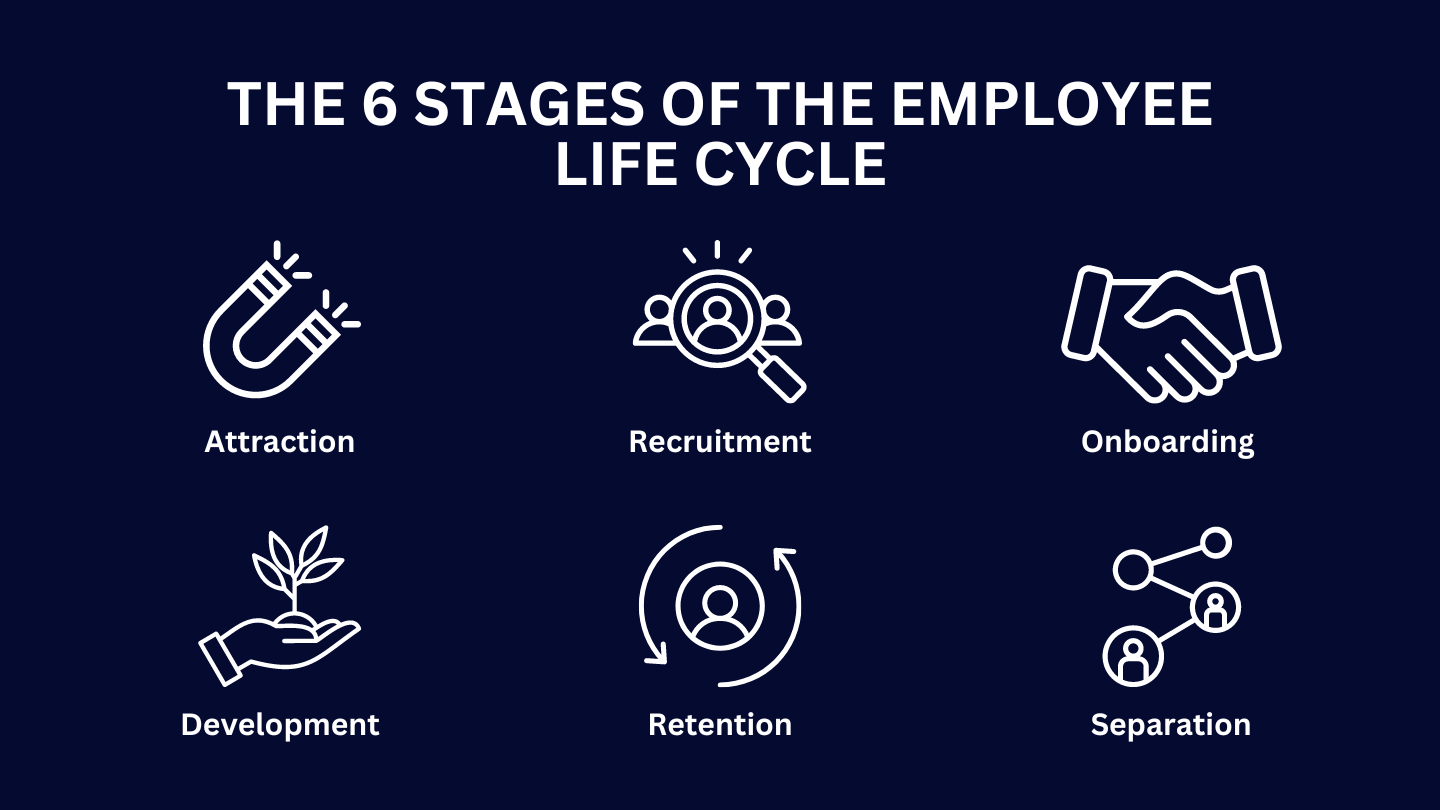Designing and encouraging an employee experience that leads to longevity, success, and great employee engagement should be a permanent mindset within your company. Rather than looking at employee engagement efforts as one-time endeavors when morale is low, the employee life cycle model frames engagement as a designed experience embedded into the trajectory of every employee within your organization.
What is the Employee Life Cycle Model?
The employee life cycle model (ELC) is an organizational method used to visualize how an employee engages with the company they are a part of. There are six stages involved in this model: Attraction, Recruitment, Onboarding, Development, Retention, and Separation.
The employee life cycle model is geared to encompass every stage of an employee’s experience within a company, formatting that trajectory into a framework that provides a different engagement strategy for each stage the employee enters. For example, if a company has an excellent and engaging recruitment strategy, but high turnover rates, they can focus on the retention stage in their ELC in order to develop a suitable solution for the issue.
The 6 Employee Life Cycle Stages
In order to understand exactly how each stage of the employee life cycle can drive employee engagement, let’s examine each stage in greater detail.

1. Attraction
The first stage of the employee life cycle is the employee attraction stage. Regardless of how innovative and strong your product or service is, without the attraction and retention of great talent, your company will fail. This makes the attraction stage one of the most crucial aspects to any organization’s growth strategy.
The attraction stage is the only stage that occurs before you have an open position in the company. Also referred to as the employer brand, it is the projection of the image of your organization as a great place to work, both in the minds of current employees as well as key stakeholders in the external market. This means that active and passive talent candidates, clients, customers, and potential stakeholders have a positive perspective of how it is to work within your company.
2. Recruitment
The second stage of the employee life cycle is the employee recruitment stage, the period where you seek out and recruit the best talent to join your organization. Recruitment can occur as a result of an existing role becoming vacant, or a new position being created altogether. The best types of recruitment plans offer an optimal candidate experience, support collaborative hiring centered around clear criteria and processes, and provide meaningful data that can be used to improve hiring results over time.
3. Onboarding
The next stage of the employee life cycle model is the employee onboarding stage. Occurring after you have recruited the top talent, the onboarding period is critical to getting your new hires well-adjusted to the organizational environment and performance aspects of their new job as quickly and smoothly as possible. During the onboarding stage, new employees cover more in-depth aspects of their position, identify the attitudes, knowledge, skills, and behaviors that are required to function effectively within the organization.
Making new hires feel welcomed in the team and well-acclimatized to the nature of both their role and the organization is critical to drawing out long-term contributions and engagement.
Book a Free meeting with our expert to discover how we can help you.
4. Development
The following stage of the employee life cycle model is the employee development stage. It is during this period that you begin to consistently encourage professional development amongst your team, which acts as a catalyst in their skill development, and also helps provide them with a future career path within the company.
5. Retention
The fifth stage of the lifecycle model is the employee retention stage. It is here that you focus your energies on keeping your top employees, and ensuring they are happy and sufficiently challenged in their respective roles within the team. The influence of company culture goes a long way in this stage. If the culture in your organization is poor, it inevitably leads to a high employee turnover rate, meaning you will have to face replacement costs regularly. Improving the retention stage is a great way to counteract this risk and promote longevity and satisfaction amongst your team’s career paths.
6. Separation
The final stage of the employee life cycle is the employee separation stage. For most employees, there comes a point where their employment lifecycle will reach its conclusion, whether from retirement, new employment, or for personal reasons. Treating the separation process with equal importance as the onboarding process and being equally as strategic in how you approach this stage, is critical. When a team member leaves, it has an effect on other members.
It is the responsibility of the manager and HR professionals within the company to ensure that the employee who is leaving, exits in a way that doesn’t cause major disruption.
Source: https://sprigghr.com/blog/360-degree-continuous-feedback/the-6-stages-of-the-employee-life-cycle/
